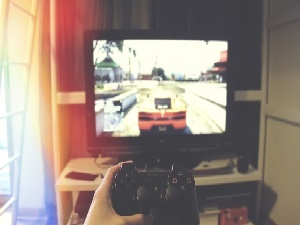



Date:13/11/18
 Samsung is developing a TV system that might one day allow users to flick channels and adjust the volume using their brains.
Samsung is developing a TV system that might one day allow users to flick channels and adjust the volume using their brains.
The so-called Project Ponthius is part of a cooperation between the South Korean electronics giant and the Center of Neuroprosthetics of the Ecole Polytechnique Fédérale de Lausanne (EPFL) in Switzerland.
The aim of the project is to give people with severe physical disabilities, like quadriplegia, a chance to enjoy their favorite shows without the help of others.
The company presented a prototype during its developer conference in San Francisco last week.
“How can we provide accessibility to people who cannot move or who have extreme limitations on their movements,’ senior scientist at EPFL Ricardo Chavarriaga said during the panel.
“We’re making tech that is more complex, that is more intelligent, but we should not forget this tech is being made to interface with humans.”
The system uses a Brain Computer Interface (BCI) to connect the viewer with the TV set.
The BCI relies on a headset covered with 64 sensors and an eye-motion tracker.
The scientists are currently taking brainwave samples to determine how the mind behaves when we have a desire to watch movies.
This could one day lead to a system that uses cues from the brainwaves to make predictions, and then eye movements to confirm.
Once selections have been made, the software will be able to build up a viewer profile and inform future suggestions, streamlining the content selection process.
Although the technology might one day help people who have been paralyzed, it is unlikely to become mainstream anytime soon.
That’s because to use the current prototype users will need to apply gel to their heads before wearing a sensor helmet, something that may be more cumbersome than spending a few minutes looking for the remote control that you lost in the sofa cushions.
Samsung and EPFL are also working on another system that will allow viewers to interact with TV sets with their brainwaves alone.
This system could be particularly useful for people who suffer from disabilities such as locked-in syndrome, the highest form of paraplegia.
Other companies are also working on BCIs that might one day allow humans to interact with machines.
They include Elon Musk’s Neuralink, which is developing ,”ultra-high bandwidth brain-machine interfaces to connect humans and computers”.
Samsung presents prototype of TV with human brain as remote control
 Samsung is developing a TV system that might one day allow users to flick channels and adjust the volume using their brains.
Samsung is developing a TV system that might one day allow users to flick channels and adjust the volume using their brains.The so-called Project Ponthius is part of a cooperation between the South Korean electronics giant and the Center of Neuroprosthetics of the Ecole Polytechnique Fédérale de Lausanne (EPFL) in Switzerland.
The aim of the project is to give people with severe physical disabilities, like quadriplegia, a chance to enjoy their favorite shows without the help of others.
The company presented a prototype during its developer conference in San Francisco last week.
“How can we provide accessibility to people who cannot move or who have extreme limitations on their movements,’ senior scientist at EPFL Ricardo Chavarriaga said during the panel.
“We’re making tech that is more complex, that is more intelligent, but we should not forget this tech is being made to interface with humans.”
The system uses a Brain Computer Interface (BCI) to connect the viewer with the TV set.
The BCI relies on a headset covered with 64 sensors and an eye-motion tracker.
The scientists are currently taking brainwave samples to determine how the mind behaves when we have a desire to watch movies.
This could one day lead to a system that uses cues from the brainwaves to make predictions, and then eye movements to confirm.
Once selections have been made, the software will be able to build up a viewer profile and inform future suggestions, streamlining the content selection process.
Although the technology might one day help people who have been paralyzed, it is unlikely to become mainstream anytime soon.
That’s because to use the current prototype users will need to apply gel to their heads before wearing a sensor helmet, something that may be more cumbersome than spending a few minutes looking for the remote control that you lost in the sofa cushions.
Samsung and EPFL are also working on another system that will allow viewers to interact with TV sets with their brainwaves alone.
This system could be particularly useful for people who suffer from disabilities such as locked-in syndrome, the highest form of paraplegia.
Other companies are also working on BCIs that might one day allow humans to interact with machines.
They include Elon Musk’s Neuralink, which is developing ,”ultra-high bandwidth brain-machine interfaces to connect humans and computers”.
Views: 604
©ictnews.az. All rights reserved.Similar news
- The mobile sector continues its lead
- Facebook counted 600 million active users
- Cell phone testing laboratory is planned to be built in Azerbaijan
- Tablets and riders outfitted quickly with 3G/4G modems
- The number of digital TV channels will double to 24 units
- Tax proposal in China gets massive online feedback
- Malaysia to implement biometric system at all entry points
- Korea to build Green Technology Centre
- Cisco Poised to Help China Keep an Eye on Its Citizens
- 3G speed in Azerbaijan is higher than in UK
- Government of Canada Announces Investment in Green Innovation for Canada
- Electric cars in Azerbaijan
- Dominican Republic Govt Issues Cashless Benefits
- Spain raises €1.65bn from spectrum auction
- Camden Council boosts mobile security





















